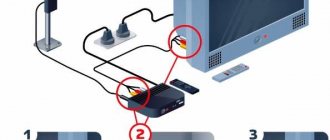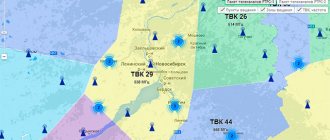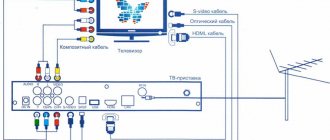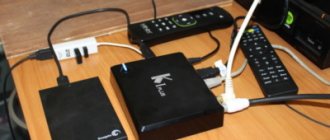Television is one of the most significant inventions of mankind, because thanks to TV, users can not only spend their time pleasantly and usefully, but also keep abreast of the latest news.
It is important for many subscribers that watching movies and programs is as comfortable as possible. This depends not only on the brand of TV and screen size, but also on the quality of the picture and sound. Since the beginning of 2019, the question of how to switch to analog TV is irrelevant, since Russia has switched to digital broadcasting. A similar practice is observed all over the world; some countries, for example, England and Lithuania, switched to digital back in 2012.
For most people, the transition to the new format went unnoticed, since modern TVs are equipped with built-in decoders. Owners of old TV receivers may need help, since they will need to do the setup themselves or contact a specialist.
Connecting digital terrestrial television
If you have the necessary materials and components, the connection is not particularly difficult. It can be done either with your own hands or with the help of a specialist. The process consists of connecting the equipment and setting it up.
Access to the digital signal can be obtained both using satellite equipment and using a television antenna.
Antenna selection and installation
The television signal is received through an antenna. The choice of antenna depends on how far away the digital signal source is located. When choosing a device, you should pay attention to its technical characteristics:
- range of received signal;
- reception range;
- what type of antenna: active or passive.
The antennas have a meter and decimeter frequency range of reception. Signals with frequencies from 48.5 to 230 MHz are received by antennas of the first type, and from 470 to 790 MHz by the second type. This type of design is considered narrowly focused. The majority of consumers purchase devices of mixed types. They contain elements that allow you to receive signals from both meter and decimeter waves.
Such antennas include the Polish antenna, colloquially called a “grid”. It has long “whiskers” diverging in rays and is responsible for receiving a meter signal. A set of short elements responsible for receiving a decimeter signal.
The choice of antenna is influenced by the distance to the television center or the nearest repeater. If your receiver is within 10 km of the source, you can use indoor antennas. Otherwise, you need to select the antenna according to the distance. In this case, the structure should be raised as high as possible and signal amplification elements should be used.
Mounting external antennas allows you to install them on masts made of pipes, metal profiles, using special brackets. If the apartment is located in multi-storey residential buildings, installation is possible on balconies and roofs. When orienting the model, structures located in the visibility zone are taken into account. They may interfere with stable reception. In this case, you need to change the position of the antenna to search for the reflected signal. Further adjustments should be made to it.
The reception range depends on whether the antenna is passive or active. The active design includes a signal amplifier. It is located directly in front of the cable through which it transmits video and receives power. The place for its installation is protected from atmospheric influences by a case.
The supply voltage can be supplied from a separate power supply or receiver. Simultaneous submission is not permitted. This may damage your digital equipment. You cannot turn on the antenna power in the tuner program if the installation of an amplifier is not structurally provided for.
Determining the location of the television tower
To find out where the nearest TV signal source is located, you can use the Internet. To do this, you need to go to the RTRS website. The site interface is simple and clear. Enter the name of your locality in the search bar. The nearest towers will be displayed on the interactive map. Next to them will be indicated: direction, broadcast frequencies, multiplex channel numbers. If there are several signal sources nearby, choose the one that your antenna picks up best.
Setting up equipment according to signal reception quality
It may happen that fulfilling all the conditions for searching, receiving and playing a digital signal on a TV does not give the desired result. The picture freezes, disintegrates into pixels, or it is not possible to configure a single channel.
In built-in or outdoor digital television set-top boxes, you can see information about the quality and signal level. In this case, the consumer is interested in the signal level. If it is in the red zone of the indicator or equal to zero, then measures must be taken to increase it. This will require a partner who will change the height, location and direction of the connected digital television antenna.
When monitoring the indicator, the time delay of the result is taken into account. This is 10-15 seconds after the completed manipulations. It is not advisable to purchase a more powerful antenna amplifier. The one that comes with the kit is designed to work with this design.
Over-amplification of the signal negatively affects the quality of reception.
It is also worth checking the power supply on the antenna board. This is 5V from the built-in power supply and 12V from the external unit. If it is absent or less, check the cable for breaks and short circuits.
Setting up antenna and television equipment
Before setting up your equipment, you need to remember the difference between analogue and digital broadcasting. In the case of analogue TV, each channel is broadcast at its own frequency. Digital broadcasting uses a pair of channels. They broadcast multiplexes that include packages of 10 programs. 20 free, digital television programs are transmitted over 2 frequency channels. All settings are made from the menu of a separate digital set-top box or TV. When using an external receiver:
- connect the antenna cable to the input of the set-top box;
- connect the set-top box to the TV using the included “tulip” or HDMI cables;
- in the TV menu, respectively, activate the AV or HDMI mode;
- From the sub-items of the set-top box menu, select “antenna power” and turn it on if necessary;
- select “settings”, this may be an inscription, or maybe an antenna logo;
- In the “settings” submenu, click on “automatic” or “manual search”.
In the case of a built-in set-top box:
- Connect the antenna cable to the connector.
- In the menu, select “country” Russia. If Russia is not on the proposed list, Fr.
- Click on auto search.
Channel search automatic or manual
There is a difference between manual search and automatic search. When using the first option, you need to know exactly which broadcast station your receiving antenna is tuned to, and on which channels this station transmits both multiplexes, as discussed above. When choosing manual search, enter the number of the desired channel and press “search”. Once the multiplex is found, it will be automatically saved and the device will exit the menu.
To search for the next channel, you need to repeat the entire procedure from the very beginning. After the channel number has been entered, pay attention to the signal level and quality. They will be shown right there. At this stage, you can change the position of the antenna in space. Having achieved high values, start searching.
In automatic mode there is no need to enter the channel number. The device itself finds everything that is there, selects a result with stable indicators and saves it.
How to choose a receiver?
To successfully set up television, you need to purchase a special set-top box. This is a special device that operates according to the DVB-T2 standard.
, which can receive a digital terrestrial signal and transmit it to a TV.
However, many modern TV models are already equipped with a built-in broadcast module, so for such citizens the task of setting up “digital” is greatly simplified.
There are various models of receivers on the shelves, the difference between which lies in price and additional features. For example, cheaper models do not support a number of additional features
– only television and nothing else. Whereas more expensive set-top boxes have more memory, can work with various Flash drives, etc.
When purchasing a digital receiver, you need to decide in advance what you need, what functions and capabilities should be present in a particular model. To main functions
The following can be included:
- The receiver must support the ability to watch TV channels in DVB-T2 format.
- You might find it useful that your TV tuner can be used as a media player to play audio files.
- Ability to use Internet services (some models support work with various media services, online cinemas, etc.)
If we have figured out the additional capabilities, now we need to decide on the external components of the receiver. It is better, of course, to give preference to models whose body is made of high-quality metal or plastic - such materials are more durable and will last much longer.
The receiver must have control buttons
(the remote control may get lost) and
various indicators
. The USB input and other additional features are usually located on the rear panel of the device (although there may be variations).
As for the equipment package, as a rule, cables for connection are included with the set-top box. For more modern TVs, an HDMI
, for older ones -
SCART
(it is also digital), for even older ones -
“tulips”
. Sometimes, to reduce the cost, manufacturers supply set-top boxes without cables, but they can be purchased separately at almost any hardware store.
The prices for set-top boxes are quite affordable: the cheapest equipment in a chain store will cost only 800 rubles
:
And, despite the low price, it has a USB port and an HDMI output - the minimum that is needed for comfortable use of the receiver. Interesting TimeShift feature
– with its help you can pause the broadcast and return to watching later (however, this usually requires a capacious USB drive).
This is conveniently implemented in a slightly more expensive receiver ( 999 rubles
), where there are 2 USB ports at once: one can be used for the TimeShift function, and through the second you can watch movies from a storage medium.
Digital cable TV connection
In hotels and apartment buildings, access to this service is possible using cable television. In this case, a local network of televisions is connected to one terrestrial digital TV receiver via cable. The service is paid. There is no need to configure anything here. Simply connect the provider's input cable to the connector and select the desired input from the menu. A similar service is provided by the provider PJSC Rostelecom. Using fiber optic cables and IPTV set-top boxes, the subscriber is provided with access to cable digital TV.
How difficult is it to retune the broadcast?
Setting up digital TV is easy. Consultants work for all Russians. The call is free: 8-800-220-20-02. Line operators will help you choose equipment and tell you how to connect the set-top box.
Volunteers can also come to help. You can get free help there too.
There are also such centers in other regions, where the shutdown of analogue transmitters will occur later. For example, in Samara, a volunteer center is already operating on the basis of the Volga Region University of Telecommunications and Informatics.
Connecting two or more TVs to one set-top box
If there are several TVs in the apartment, the problem arises of connecting them to 1 set-top box. There are several options:
- Connect 1 TV with an HDMI cable, and the second with an RCA cable (tulip). You can connect as many TVs as there are outputs on the set-top box. Select cables of the required length and make the connection. The disadvantage is that the image is the same on all TVs.
- Buy an RF modulator and distribute the signal to several receivers. The modulator has several outputs, is powered by a 220V network, and has its own interface. In it you can configure individual channels for TVs. When assigning virtual numbers to channels, make sure that they do not have numbers similar to the channel numbers of multiplexes. Select the prescribed channel from the TV menu. Wiring is carried out using RCA cables. The cost of individual devices may exceed the cost of the set-top box.
Who exactly can receive these compensations?
Payments are provided for the following categories of citizens:
- WWII veterans and former minor prisoners of fascism;
- disabled people of the Second World War and combat operations;
- family members of deceased (deceased) disabled people and participants in the Great Patriotic War;
- non-working single pensioners who do not belong to preferential categories;
- elderly people living in families consisting of non-working pensioners;
- low-income families;
- low-income single Russians receiving social assistance.
- You can apply for payments from September 1, 2021 to June 30, 2019. You can apply for compensation through government services.
Which terrestrial TV channels are available for free in digital format?
The RTRS company offers 2 multiplexes. You have already learned how to determine the channel numbers on which they broadcast in your area. The multiplexes themselves have the following content:
- one includes: Channel One, Russia 1, NTV, Russia Culture, TVC, OTR, Fifth, Match TV, Russia-24, Carousel;
- the second contains: Ren TV, Domashny, Spas, Mir, TV-3, TNT, Muz TV, Friday, Zvezda, STS.
You should not try to find more channels than the repeater broadcasts. After digital broadcasting across Russia is put into normal operation, the number of channels will increase over time.
What is needed to receive DVB-T2
In general, if you have nothing, then you need to purchase:
Any TV that supports the DVB-T2 standard.
Antenna.
Antenna amplifier. You will need this device if you are in an area with poor signal reception.
High frequency cable compatible with antenna and terrestrial signal amplifier.
Connecting wires, if you have the ability to connect satellite, cable and Internet broadcasting to your TV.
Storage devices for information storage. You will need them to store movies and TV shows.
Cutter. A special device that disconnects expensive equipment from the 220 V network in the event of a voltage surge. You can buy a modern stabilizer, but it is more expensive.
We previously looked at two main devices. Tuner and TV. Let's now look at the receiving path.
Satellite channels
Users who have a parabolic antenna are interested in the question of how to set up satellite channels? Let us immediately warn you that these operations are slightly different from the actions described above.
So, the dish (as the satellite dish is popularly called) has already been installed and pointed in the right direction, all that remains is to figure out how to set up the TV. Along with the dish on the balcony, a receiver or tuner appears in the room, connected to it with a cable. Your equipment is switched to ordinary monitor mode.
Few buyers know that a satellite dish, due to the influence of natural conditions - strong wind, heavy rain, etc., can change its original position, so you need to periodically check the device and adjust the position so that there is a stable signal without distortion.
The tuner has its own remote control, on which you need to press the “Menu” button. Following the prompts, which are described in detail in the instructions, satellite channels are configured. There are many of them, so choose only the ones you need that you will look at at least occasionally. From the practice of using satellite television, it follows that many channels are offered, but the most popular are educational, about travel and the mysteries of the planet, and sports. Therefore, when setting up, do not get carried away by the abundance of saved channels: as a rule, you simply do not have enough free time to watch everything.
Why doesn't the TV show?
You may be in an area of poor reception. If the TV previously showed interference, then the automatic search for transmission channels may not work. Find the channel manually. But even in this case, the picture may freeze, and even disappear completely in the rain. To fix this problem, you need to amplify the input signal. Install a modern antenna with an amplifier and tune it to the tower.
Check the HF cable. Sometimes it gets torn off by a tree branch or chewed by mice.
If you do not have a cut-off device, then a power surge may damage the power adapter of the set-top box. Then it needs to be replaced.
Now we have a good idea of what you need to know to watch digital terrestrial television at home. It would be logical to consider the best tuners.
Setting up HD channels
“High Definition Television” (HDTV) is a completely new standard that provides a much better picture when compared to analog and digital options. This format allows for highly compressed video and audio signals and uses only digital technology to transmit the signals, resulting in very impressive image fidelity and surround sound.
If you have already set up digital channels on your new TV, then to add channels in HD mode you need to automatically rescan - they will appear in the product list.










